John & Sun-Ling are winding down in Shanghai after a two-year tenure and are planning for a 5-month adventure in southern China and northern SE Asia. Go to http://meckleyearth.blogspot.com for our upcoming travels.
Friday, June 29, 2007
In Flight
A few weeks ago we flew to Shenyang on Spring Airlines, a low-fare carrier based in Shanghai. They really are a budget airline. You get a free bottle of water, but must pay for all other snacks, food, and beverages. All seats are economy class and the leg room is pretty tight. There are no magazines in the "seat pocket in front of you" and there is no in flight entertainment... Well that's not exactly true. Watch this video I shot.
Thursday, June 28, 2007
Photos from ZhenJiang Trip (updated)
All of the photos (with descriptions) from our recent trip to ZhenJiang can be found here.
And a few videos here, here, here, and here.
And a few videos here, here, here, and here.
Monday, June 18, 2007
Riding the Ferry from Zhenjiang to Guazhou (and back)
A few weeks ago, Sun-Ling and I made a weekend trip to Zhenjiang, China.
Zhenjiang, an ancient town, is located about 100 miles west of Shanghai at the confluence of the Yangtze River and the Grand Canal. It is mentioned by Marco Polo as the place he landed after crossing the Yangtze on the way to Hangzhou. I did not verify this from the original source but it’s mentioned in all the Zhenjiang travel websites so it must be true. ;-)
One cannot exactly retrace the Yangtze crossing of Polo from Guazhou on the north bank to Zhenjinag on the south but you take the modern ferry from the outskirts of Guazhou (a very small town even by Chinese standards) to the outskirts of Zhenjiang. The cost is 3 RMB each way and you get to walk on the ferry along side the cars, taxis, buses, tractors, and bicycles. Bus #110 takes you from the Zhenjiang train station right to the ferry landing in about 30 minutes. The ride itself is fantastic, about 15 minutes long, you can basically go anywhere on the ferry, and there is lots river traffic to watch.
There appeared to be 4 ferries operating the day we were there with almost no waiting time between departures. Strange to me as there is a massive, newly completed bridge just a few hundred meters downstream. The talkative ticket taker told us that the ferry is kept open/running for military reasons and that it’s cheaper than the toll on the bridge.
Once on the Guazhou side, it’s a 10 to 20 minutes walk along the Yangtze River levee to Guazhou town and the Ancient Ferry Scenic Park or you can hire a minivan or taxi. The fare is anywhere between 2 to 10 RMB per person depending on your negotiating skills. We walked. See photos. We had to ask directions several times. See video.
The Ancient Ferry landing at Guazhou is now a park, admission 8 RMB (about 1 USD), where one can see the old landing (a bunch of rocks and concrete) and the newer, operational, canal locks. The park is not well maintained.
We did not have time to find the old ferry landing on the Zhenjiang side but the guide books say it exists.
Here are some photos and some video of the ferry excursion.
Boarding the ferry at Guazhou. We are boarding the one at left. The one at right has almost arrived. Check out the tractor.
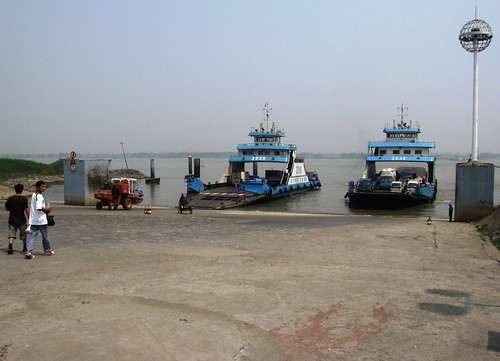
Riding the ferry. You can see the new bridge in the background.
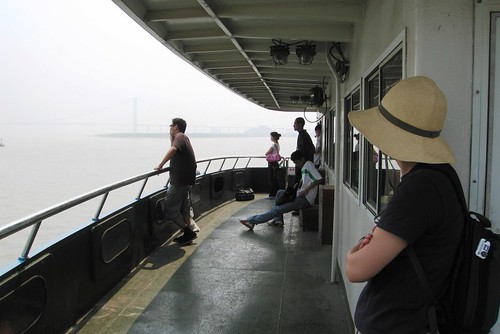
Walking to Guazhou along the levee that protects the town from the Yangtze (river to the right).
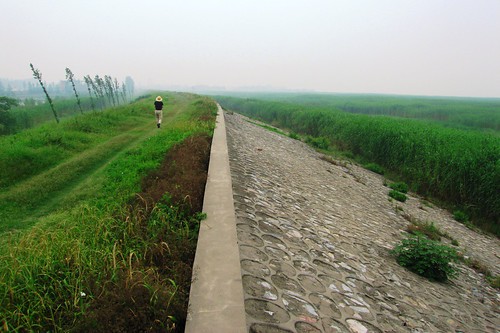
Video of Sun-Ling asking directions in Guazhou Town.
The site of the ancient ferry landing at Guazhou.
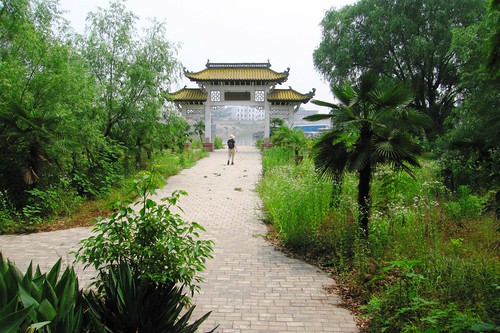
Locks on the Grand Canal - part of the Ancient Ferry Scenic Area.
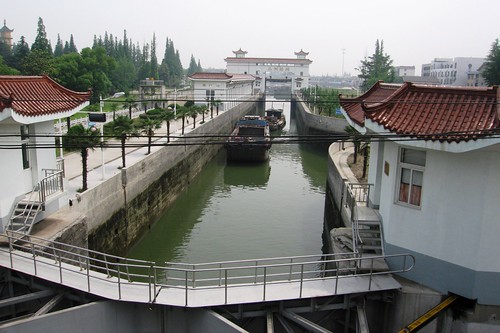
The one on the left is loading, the one I'm on has just pulled out.
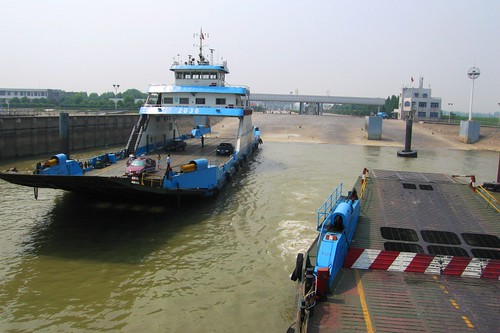
Video of the ferries in action.
Zhenjiang, an ancient town, is located about 100 miles west of Shanghai at the confluence of the Yangtze River and the Grand Canal. It is mentioned by Marco Polo as the place he landed after crossing the Yangtze on the way to Hangzhou. I did not verify this from the original source but it’s mentioned in all the Zhenjiang travel websites so it must be true. ;-)
One cannot exactly retrace the Yangtze crossing of Polo from Guazhou on the north bank to Zhenjinag on the south but you take the modern ferry from the outskirts of Guazhou (a very small town even by Chinese standards) to the outskirts of Zhenjiang. The cost is 3 RMB each way and you get to walk on the ferry along side the cars, taxis, buses, tractors, and bicycles. Bus #110 takes you from the Zhenjiang train station right to the ferry landing in about 30 minutes. The ride itself is fantastic, about 15 minutes long, you can basically go anywhere on the ferry, and there is lots river traffic to watch.
There appeared to be 4 ferries operating the day we were there with almost no waiting time between departures. Strange to me as there is a massive, newly completed bridge just a few hundred meters downstream. The talkative ticket taker told us that the ferry is kept open/running for military reasons and that it’s cheaper than the toll on the bridge.
Once on the Guazhou side, it’s a 10 to 20 minutes walk along the Yangtze River levee to Guazhou town and the Ancient Ferry Scenic Park or you can hire a minivan or taxi. The fare is anywhere between 2 to 10 RMB per person depending on your negotiating skills. We walked. See photos. We had to ask directions several times. See video.
The Ancient Ferry landing at Guazhou is now a park, admission 8 RMB (about 1 USD), where one can see the old landing (a bunch of rocks and concrete) and the newer, operational, canal locks. The park is not well maintained.
We did not have time to find the old ferry landing on the Zhenjiang side but the guide books say it exists.
Here are some photos and some video of the ferry excursion.
Boarding the ferry at Guazhou. We are boarding the one at left. The one at right has almost arrived. Check out the tractor.

Riding the ferry. You can see the new bridge in the background.

Walking to Guazhou along the levee that protects the town from the Yangtze (river to the right).

Video of Sun-Ling asking directions in Guazhou Town.
The site of the ancient ferry landing at Guazhou.

Locks on the Grand Canal - part of the Ancient Ferry Scenic Area.

The one on the left is loading, the one I'm on has just pulled out.

Video of the ferries in action.
Labels:
ferry,
guazhou,
jiangsu,
transportation,
zhenjiang
Saturday, June 16, 2007
Bad climate
We went to Shenyang last weekend. My first trip outside the Great Wall. I felt rather cheated by the weather. We flew 1200 km northeast, mostly north, from Shanghai to Shenyang. The daytime high in Shenyang, a city that got 1 meter of snow early this March, was 10 degrees higher than Shanghai. It was hot. I thought Shanghai had bad climate - one wishes for summer in the winter and winter in the summer....
Now I am convinced that the whole of China is plagued by bad climate. It never fails to amaze me that this great a population density could be produced in such a bad climate. I guess mass migration is conditioned by both culture and economy.
Now I am convinced that the whole of China is plagued by bad climate. It never fails to amaze me that this great a population density could be produced in such a bad climate. I guess mass migration is conditioned by both culture and economy.
Shanghai's Bad Climate - The Proof
Last year I published an hypothesis on this blog
On purpose, I published the statement with no supporting data and was a bit surprised to receive no comments, questions, challenges, nor congratulations to what I thought was a brilliant, new, and provocative insight. Sigh....
So, now with much humility, I am belatedly publishing the proof. I used data from BBC Weather comparing Shanghai's January weather to that of San Diego, New Orleans, Marrakech, and Alexandria. As a bonus, July is also included.
Here is the same data. [I've been playing with google docs again. ;-)]
Shanghai has the coldest winters of any city in the world at similar latitude and elevation.
On purpose, I published the statement with no supporting data and was a bit surprised to receive no comments, questions, challenges, nor congratulations to what I thought was a brilliant, new, and provocative insight. Sigh....
So, now with much humility, I am belatedly publishing the proof. I used data from BBC Weather comparing Shanghai's January weather to that of San Diego, New Orleans, Marrakech, and Alexandria. As a bonus, July is also included.
Here is the same data. [I've been playing with google docs again. ;-)]
Tuesday, June 12, 2007
GFW strikes again
Since June 7th, I see this when I log into my flickr account.

No pics! That's right. I can upload photos, edit titles and descriptions, but I can't see the photos themselves. Looks the Great Firewall of China - GFW - has struck again.
The current official Flickr position is

No pics! That's right. I can upload photos, edit titles and descriptions, but I can't see the photos themselves. Looks the Great Firewall of China - GFW - has struck again.
The current official Flickr position is
11 June 23:30 (PDT)
We know images from Flickr are still blocked and definitely care very much about our friends who cannot access pictures. We have been contacting people to hopefully get a positive resolution with restoration of photos, but this of course has not happened yet. The Flickr team is very sorry for this continued issue and will update you when we have more to share.
Posted 66 minutes ago.
Sunday, June 03, 2007
Riding the Bullet Train to Zhenjiang
China Railways has recently introduced new "bullet trains" on several routes in and out of Shanghai. The trains are called CRH in English, short for China Railway High-Speed, and Hexie Hao "The Harmonious" in Chinese.
I took some photos earlier this year of the CRH's rolling by the Lianhua Lu Metro Station on their way to Hangzhou. Last weekend we finally got to ride one as we spent the weekend in Zhenjiang, China - a city on the Yangtze River, east of Nanjing.
I left work early and we arrived at Shanghai Station just after 5PM. We tried to enter the station via the usual Soft Seat Waiting Room but were politely told we must enter through the CRH entrance. Duh. How did we miss those blue CRH signs?
Avoiding the scuffle at the ticket entrance (a guy and his girl friend tried to enter without tickets) we headed down to platform 13 where the sleek (you might say virile) new CRH was boarding for the 17:30 trip to Nanjing - the D442. Great! And to my delight, just across the platform another CRH was waiting - the 17:35 to Nanjing (D444). I handed the luggage to Sun-Ling and took a few photos before getting on the train.
Unlike the Japanese Shinkansen, this train does not travel on specially built tracks. It uses the regular "electric-overhead" tracks and the highest speed we noted on the car-end ticker was 205 km.
Looking at the photos, you see a "nose cap" on the locomotive. That's because the normal 8-car trains can be coupled together, nose-to-nose, to make a 16-car train. You can see this in the video. The train to Zhenjiang was 8-car, the return 16.
With a 3 X 2 seat configuration, tray tables, seat-back "car-layout" diagrams, smart attendant's uniforms, men's standing toilets, and 100 percent non-smoking cars, the CRH is reminiscent of the Shinkansen. However you will find no "silence car", bowing conductors or polite "cart girls". Both trains we rode were filled with the usual busy and boisterous crowd, with about 10 "standing room" patrons per car, and unflappable attendants.
The cars have differing seat capacities and configurations which don't always agree with the seat-back charts. Car #3 on our return trip had 85 seats - 17 rows.
The rows of seats can be flipped around to face the other way. Wanna see how it's done? Click here.
We were pleasantly surprised to see orderly queues at the Kunshan Station, the first stop. Passengers boarding the train were lined up to enter at the rear of their assigned car, departing passengers left through the front exit. The doors are at platform level which makes entering and exiting quite easy.
We were able to buy the 2 sets of tickets just 5 days in advance from our local Xujiahui branch of China Railways. However, the all the return trains from Zhenjiang were sold out for Sunday night so we bought return tickets from Nanjing, the station of origin even though it cost more.
On Sunday we had a bit of a problem at the Zhenjiang Station. In China, train tickets are not checked by a conductor but are checked as you enter the station/platform and as you board the train. So when we presented our Nanjing to Shanghai tickets to the guy checking the tickets at the CRH entrance to the Zhenjiang Station, he gave them a long hard look. Then he called over his supervisor. She look at them for awhile and then let us through with the caveat that she couldn't guarantee our seats on the train.
Of course we had no trouble claiming our seats once on the train. You can watch us board the train and Sun-Ling boot out the interlopers on this video.
Here are a few more photos from the Shanghai Station.
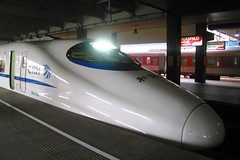
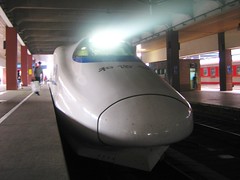
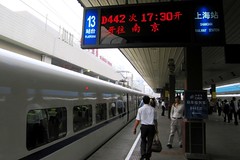
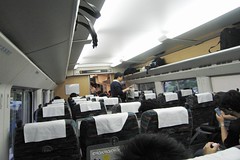
I took some photos earlier this year of the CRH's rolling by the Lianhua Lu Metro Station on their way to Hangzhou. Last weekend we finally got to ride one as we spent the weekend in Zhenjiang, China - a city on the Yangtze River, east of Nanjing.
I left work early and we arrived at Shanghai Station just after 5PM. We tried to enter the station via the usual Soft Seat Waiting Room but were politely told we must enter through the CRH entrance. Duh. How did we miss those blue CRH signs?
Avoiding the scuffle at the ticket entrance (a guy and his girl friend tried to enter without tickets) we headed down to platform 13 where the sleek (you might say virile) new CRH was boarding for the 17:30 trip to Nanjing - the D442. Great! And to my delight, just across the platform another CRH was waiting - the 17:35 to Nanjing (D444). I handed the luggage to Sun-Ling and took a few photos before getting on the train.
Unlike the Japanese Shinkansen, this train does not travel on specially built tracks. It uses the regular "electric-overhead" tracks and the highest speed we noted on the car-end ticker was 205 km.
Looking at the photos, you see a "nose cap" on the locomotive. That's because the normal 8-car trains can be coupled together, nose-to-nose, to make a 16-car train. You can see this in the video. The train to Zhenjiang was 8-car, the return 16.
With a 3 X 2 seat configuration, tray tables, seat-back "car-layout" diagrams, smart attendant's uniforms, men's standing toilets, and 100 percent non-smoking cars, the CRH is reminiscent of the Shinkansen. However you will find no "silence car", bowing conductors or polite "cart girls". Both trains we rode were filled with the usual busy and boisterous crowd, with about 10 "standing room" patrons per car, and unflappable attendants.
The cars have differing seat capacities and configurations which don't always agree with the seat-back charts. Car #3 on our return trip had 85 seats - 17 rows.
The rows of seats can be flipped around to face the other way. Wanna see how it's done? Click here.
We were pleasantly surprised to see orderly queues at the Kunshan Station, the first stop. Passengers boarding the train were lined up to enter at the rear of their assigned car, departing passengers left through the front exit. The doors are at platform level which makes entering and exiting quite easy.
We were able to buy the 2 sets of tickets just 5 days in advance from our local Xujiahui branch of China Railways. However, the all the return trains from Zhenjiang were sold out for Sunday night so we bought return tickets from Nanjing, the station of origin even though it cost more.
On Sunday we had a bit of a problem at the Zhenjiang Station. In China, train tickets are not checked by a conductor but are checked as you enter the station/platform and as you board the train. So when we presented our Nanjing to Shanghai tickets to the guy checking the tickets at the CRH entrance to the Zhenjiang Station, he gave them a long hard look. Then he called over his supervisor. She look at them for awhile and then let us through with the caveat that she couldn't guarantee our seats on the train.
Of course we had no trouble claiming our seats once on the train. You can watch us board the train and Sun-Ling boot out the interlopers on this video.
Here are a few more photos from the Shanghai Station.




Subscribe to:
Comments (Atom)